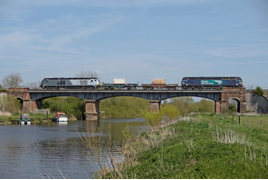Another contribution to reduced life-cycle costs is a planned bogie overhaul interval of one million miles, well beyond that for Class 66s. Part of the explanation for this high performance comes from the locomotive’s dynamics.
While the Class 68 has proved to be a highly effective design, in 2013 DRS saw a market for a dual-mode traction unit. This would be an electric locomotive but with a small diesel engine for operation on lines without an overhead line supply, such as in freight terminals. The dual-mode concept is not new, having been used in the Southern Region Class 73 and ‘74’ third rail locomotives.
Concurrently, but independently, the engineers at Valencia were also evaluating the possibility of a dual-mode version of the EUROLight in order to compete against other locomotive manufacturers. The result was an order in September that year for ten UKDuals (Class 88 on TOPS), one month before South Africa ordered 50 AfroDuals.
The ‘88’ shares 70% of the components used in a Class 68 - including the cabs, bodyshell, bogies, control equipment and traction drives. When operating in electric mode and drawing current from a 25kV, 50Hz overhead line supply, it is rated continuously at 4,000 kW (5,360hp). Maximum speed is 100mph, and this performance characteristic is framed for passenger work and also the haulage of 1,800-tonne freights.
The successful operation of the ‘68’ engine, and the strong support offered by Caterpillar (98.7% of spares are held in the UK, and the balance can be delivered in 24 hours), led to the decision to use another of that company’s ACERT range for Class 88. The 12-cylinder C27 of 708kW (950bhp) at 1,750rpm (manufacturer’s rating 1,800rpm) is compliant with the current EU Stage IIIB emission limits. This rating gives an indication of planned duties when operating in diesel mode, because the available power is quite limited by choice and puts an ‘88’ on a par with a DRS Class 20.
An interesting feature is the use of a fifth traction motor attached to the diesel engine, which serves as a traction alternator. This saves the use of a bespoke alternator for electricity generation when operating in diesel mode. To maintain its ubiquity, the maximum tractive effort is available in either mode.
Class 88 locomotives have both dynamic and regenerative brake systems, as well as train air braking equipment. Up to 4mW of current can be returned to the overhead line during braking, where the catenary can absorb it.
Running ‘light locomotive’, an ‘88’ can accelerate from standstill to 60mph in 13 seconds. This is as quick as a small family car, and proves that the installed power can be turned into usable tractive effort from rest.
The highly distinctive DRS branding for both classes was devised in conjunction with Ast Transport Branding of Penrith. While the compass logo on the ‘68s’ incorporates a map of Carlisle, a map of Crewe is used for the ‘88s’.
Names will be applied to the ‘88s’. While 68001 was named Evolution, 88001 will become Revolution in recognition of its game-changing features. And just as with the ‘68s’, the locomotives have been bought by Beacon Rail Leasing and leased to DRS.
Class doyen 88001 was sent to Velim in April for proving trials, which went “extremely well”. A 1,500-tonne train, plus an 80-tonne locomotive, was used during the vehicle approvals process. Performance under different conditions and when switching between diesel and electric modes was also studied.
It was unveiled to the public in July, and 88003 was exhibited at InnoTrans in September.
By mid-October, construction at Valencia had progressed to the stage where 88007 was complete, including DRS branding. The first ‘88’ to arrive in the UK will be 88002 Prometheus, which will be shipped across in January. It will be used for homologation purposes, and deliveries of all ten are expected to be completed by March 2017. RSSB (Rail Safety and Standards Board) approval for UK operation is planned to be agreed the month before. Electrified lines have around 35 different variations of catenary, and the interface between these and the Class 88 pantograph will be a key part of the acceptance process.
The final batch of ‘68s’ will be delivered from Valencia by July 2017. Once the homologation process has been completed, the ‘88s’ first duty will be to haul the Daventry to Mossend Tesco service. This path is timed for an electric locomotive and currently requires the use of two ‘68s’ in multiple. Other diagrams will then target trains that currently run under the wires with diesel traction.
The DRS/Valencia relationship has proved to be a successful one. Bush contrasts the manufacturer’s attitude to modifications as a case in point. To date, there have been nine software updates to Class 68s. In contrast, for a Class 66, it would take two years to get approval for a modification and then a further two for its implementation.















Login to comment
Comments
No comments have been made yet.